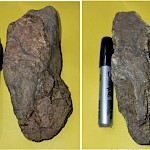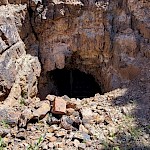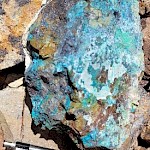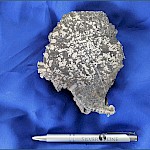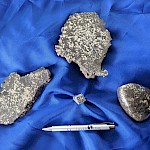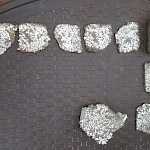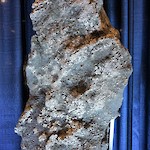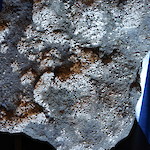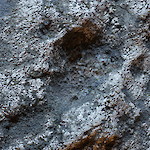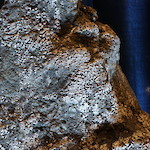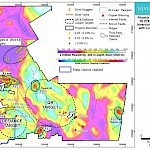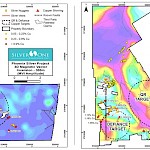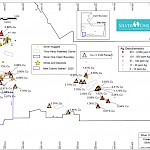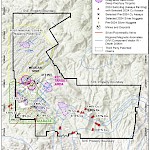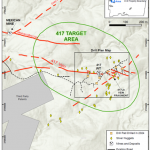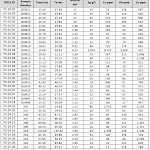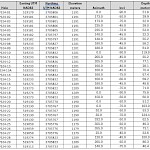-
Snapshot
The Phoenix Silver Project is located within the “Arizona Silver Belt”, which occurs on the margins of the prolific copper producing area near Globe, Arizona. Copper giants such as BHP, Rio Tinto, and Freeport McMorran all have producing mines in the area. The Arizona Silver Belt hosts several small historic silver producers, such as the McMorris, Buckeye and Stonewall Jackson Mines, all of which lie immediately east of Silver One’s Phoenix Silver Project (see location map). Native silver and other silver bearing minerals characterize these deposits.
The Phoenix Silver project is an early-stage exploration prospect. Several native-silver vein fragments have been uncovered from beneath the overburden (see showing and samples map). The fragments are interpreted to be derived from nearby vein structures as determined by both the intergrowth of the quartz and carbonate with native silver and other silver minerals and by the non-abraded physical nature of the fragments (i.e. they have not been transported very far).
One sample that was recovered from the central area of the property (see showing and sample map) weighed 417 lbs and a specific gravity measurement in combination with the visual presence of abundant native silver attests to a high silver content (see 417 Ibs fragment photo). This exceptionally rare fragment was not assayed in order to preserve the specimen quality of the sample.
One 8.5 kg (18.7 lbs) sample (see multiple fragment photo) was assayed by concentrate sampling techniques at Skyline Assayers and Laboratories in Tucson, Arizona. This assay returned very high grades of 459,000g/t silver (14,688 oz/ton or approximately 46% Ag).
Several vein structures are partially exposed on the property. Some of these have been sampled, with assays from grab samples returning silver values between below detection limit (0.5g/t) to 2,550g/t and assays from chip samples returning silver values from below detection limit to 557g/t. The chip samples were collected from outcrops over an area between one to two square meters at each site – see analytical details for surface rock samples below. Most of the veins trend east-west, similar to mineralized structures in the nearby McMorris and Buckeye historic mine (on third-party ground). The projection of some of these veins occur just upslope from the areas where the large silver bearing vein fragments were located (see showing and samples map).
In the southern portion of the property multiple copper and silver showings suggest potential for the discovery of porphyry-related copper mineralization. These new copper showings (mainly veins and breccias) have returned selected samples with highly anomalous copper from 0.1% to 7.79% and silver between 1 g/t and 1,240 g/t and also with locally abundant lead and zinc.
Analytical Details
Grab and chip samples varied from 1 kg to 5 kg and were assayed by Skyline Assayers & Laboratories (“SAL”) in Tucson, AZ, USA (IAS accredited Laboratory, ISO/IEC 17025:2017). Samples were analyzed for 49 elements by ICP-MS, Ag was analyzed by AA aqua regia digestion, with over limits by fire assay gravimetric. Cu, Pb, Zn over limits were analyzed either by ICP-OES or aqua regia-AAS. Silver nuggets and fragments were analyzed by either ore-grade volumetric fire assay gravimetric assay or calculated by specific gravity methods. SAL inserts blanks, standards and includes duplicate analyses to ensure proper sample preparation and equipment calibration.
Analytical Details - Drill Core Sampling
Seventy-six rock samples from core drilling were collected by Company geologists. All core was drilled in HQ diameter and samples were saw-cut on site after being washed, logged, photographed and analyzed with a portable X-ray pXRF Delta Professional analyzer. One-half was used for wet-chemical analysis and the other half returned to its box for storage at a company facility in Globe, Arizona. Samples varying in size from approximately 1kg to 11kg were dropped off by Company personnel at SGS Laboratories (“SGS”) sample preparation facility in Tempe, AZ, thence shipped by SGS personnel to SGS laboratory in Burnaby, BC., Canada (ISO accredited Laboratory, ISO/IEC17025:2017, SCC file # 15919) for analysis. Samples were analyzed by ICP-MS for thirty-four elements with four-acid digestion (SGS code GE.ICP40Q12). Overlimit copper, lead and zinc were analyzed by ore-grade four acid digestion ICP-MS (0.5 g sample) code GE.ICP42Q100. Overlimit silver was analyzed by 30 g FA/Gravimetric assay (code GO.FAG37V). Silver One inserted three standards (sourced from OREAS® Certified Reference Material), three blanks and one duplicate in the sample stream. No analytical issues were observed. SGS also inserts blanks, standards and includes duplicate analyses to ensure proper sample preparation and equipment calibration.
-
Recent Exploration
In October 2024, a helicopter-borne ZTEM electromagnetic survey was completed over the entire property by Geotech LTD (“Geotech”). Geotech’s processing, 3D-modelling, and targeting analysis have identified several significant anomalies potentially related to copper and silver mineralization. Anomalies identified include two priority copper targets and five priority silver targets, all recommended for further exploration (Map ref?).
In late 2024, Silver One completed a diamond drill program in the 417 area (Map ref?). The close spaced drill program targeted an east-west trending, steeply dipping structure, just upslope from the large (417 pounds) angular vein fragment thought to be derived from these structures. With the exceptions of hole 1 that did not intersect the vein, hole 10 (barren) and hole 22 that did not recover core in the vein zone, elevated silver and or base metals (Zn, Pb, Cu), values were encountered in all other holes along the 250 meters of the east-west vein (Fig ref?- Table of selected results from news rel?). See analytical details for drill core below.
The program consisted of 30 core holes from 6 drill pads, totalling 1,955 meters which traced the vein- structures for over 250 m east-west. The drill holes were drilled in HQ size core (63.5mm diameter) with an average depth of 64 m. The best intercept returned 3,800 g/t silver with 0.97% copper over 0.35 m within a quartz breccia (See selected assays in Fig. ?). This intersection is near the 417 vein fragment area. The presence of silver and base metals along the length of the structure tested suggests this fracture system may still host higher-grade material between the drill hole intercepts, as well as elsewhere along the western and eastern extensions of the host structure.
Analytical Details
Grab and chip samples varied from 1 kg to 5 kg and were assayed by Skyline Assayers & Laboratories (“SAL”) in Tucson, AZ, USA (IAS accredited Laboratory, ISO/IEC 17025:2017). Samples were analyzed for 49 elements by ICP-MS, Ag was analyzed by AA aqua regia digestion, with over limits by fire assay gravimetric. Cu, Pb, Zn over limits were analyzed either by ICP-OES or aqua regia-AAS. Silver nuggets and fragments were analyzed by either ore-grade volumetric fire assay gravimetric assay or calculated by specific gravity methods. SAL inserts blanks, standards and includes duplicate analyses to ensure proper sample preparation and equipment calibration.
Analytical Details - Drill Core Sampling
Seventy-six rock samples from core drilling were collected by Company geologists. All core was drilled in HQ diameter and samples were saw-cut on site after being washed, logged, photographed and analyzed with a portable X-ray pXRF Delta Professional analyzer. One-half was used for wet-chemical analysis and the other half returned to its box for storage at a company facility in Globe, Arizona. Samples varying in size from approximately 1kg to 11kg were dropped off by Company personnel at SGS Laboratories (“SGS”) sample preparation facility in Tempe, AZ, thence shipped by SGS personnel to SGS laboratory in Burnaby, BC., Canada (ISO accredited Laboratory, ISO/IEC17025:2017, SCC file # 15919) for analysis. Samples were analyzed by ICP-MS for thirty-four elements with four-acid digestion (SGS code GE.ICP40Q12). Overlimit copper, lead and zinc were analyzed by ore-grade four acid digestion ICP-MS (0.5 g sample) code GE.ICP42Q100. Overlimit silver was analyzed by 30 g FA/Gravimetric assay (code GO.FAG37V). Silver One inserted three standards (sourced from OREAS® Certified Reference Material), three blanks and one duplicate in the sample stream. No analytical issues were observed. SGS also inserts blanks, standards and includes duplicate analyses to ensure proper sample preparation and equipment calibration.
-
Photos
-
Maps

